The two longest plate appearances of 2013 (to date) took place two innings apart in Monday’s Rays-Marlins game at Tropicana Field. They both involved right-handed rookie pitchers who were facing batters for the first time in the big leagues. And like last week, I’m going to go over them both.
Longest Plate Appearance(s) of the Week, 5/23-5/29
May 27, Marlins at Rays
Jake Odorizzi vs. Jordan Brown, 14 pitches (tied for longest of 2013)
AND
Jose Fernandez vs. Matt Joyce, 14 pitches (tied for longest of 2013)
Odorizzi battled Brown in the second inning, and Fernandez vs. Joyce followed in the fourth. We’ll take them in order.
Odorizzi vs. Brown
Length: 4:53
Mound visits: 0
Brown’s longest previous plate appearance: 9
Previous longest plate appearance vs. Odorizzi: 12
2013 League-average P/PA: 3.85
Brown P/PA (career): 3.67
Slowey P/PA against: 4.40
Previous match-up history: None
Before we begin, let’s all just level with each other and admit that we know nothing about Jordan Brown. I’m impressed if you’ve heard of him and aren’t a Marlins fan. (Actually, I’m more impressed if you are a Marlins fan.) Brown doesn’t have a comment in Baseball Prospectus 2013; to find him, you’d have to go back to the previous edition of the annual, which contains this comment:
Jordan Brown is stuck betwixt and between—he’s battered Triple-A pitching around for years, but not quite enough to play a corner position, and he isn’t rangy enough to start in center field.
Last season, Brown hit .294/.337/.426 as a 28-year-old first baseman/corner outfielder, splitting time between the Brewers’ Triple-A affiliate and the Mexican League. He started this season with a .261/.305/.336 line in 129 plate appearances for New Orleans, getting the call to Miami when Matt Diaz hit the disabled list last week. His only previous major league experience came in an August-September stint with Cleveland in 2010, during which he hit .230/.272/.310. He’s the most anonymous and marginal Marlin, which probably makes him the most anonymous and marginal major leaguer.
Odorizzi, while inexperienced, is a much more promising player—he’s a few months removed from earning the 83rd spot on our preseason Top 101. But the 23-year-old has his flaws. Here’s the negative part of Odorizzi’s writeup in the Rays Top 10:
Weaknesses: Lacks knockout pitch; arsenal is solid-avg, but lacks upside; fastball can flatten out when elevated; secondary offerings aren’t consistent enough to back hitters off fastball; gets loose in the zone and struggles to put hitters away.
Rays fans have seen those weaknesses manifested on the field. Among pitchers who’ve made at least two starts, Odorizzi’s 4.40 pitches per plate appearance rank third. And the percentage of his pitches thrown on two-strike counts—37.2—ranks fifth, well above the 28 percent league average. Granted, we’re talking about nine innings (although four of them were against Miami), so caveat accordingly. But thus far, the performance matches the profile of a pitcher who can’t put people away.
Let’s take a look at what we can learn from Odorizzi’s extended struggle with Brown.
The plot (catcher’s perspective):
These pitches aren't clustered as tightly inside the strike zone as most of the sequences we've seen in previous weeks. Brown helped prolong this plate appearance by expanding his zone.
The exhausted player:

The sequence:
1. 0-0: 71-mph curveball, called strike

There's no way I'm not going to get through a 14-pitch plate appearance involving a Rays pitcher without mentioning Jose Molina, so I might as well get the Molina mention out of the way early. This curve was perfectly placed at the bottom of the zone, and Molina plucked it up to ensure that the ump wasn't swayed by the pitch's downward trajectory after it passed the plate.
2. 0-1: 86-mph changeup, ball
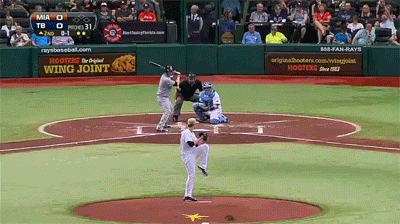
Odorizzi aims for the corner, but the "arm-side fading action" Jason Parks mentioned in his Top 10 scouting report carries the change outside.
3. 1-1: 70-mph curveball, foul

Here's our first example of Odorizzi getting "loose in the zone." He goes back to the curve, aiming outside again, but the pitch drifts inside and gets too much of the plate. Fortunately for Odorizzi, Brown doesn't do anything with it.
4. 1-2: 92-mph four-seamer, foul

The first fastball of the plate appearance. Odorizzi's velo is about average for a right-handed starter, but Brown has seen only off-speed stuff and breaking balls so far, so he's late on the heater.
5. 1-2: 92-mph four-seamer, foul

Odorizzi elevates and induces Brown's worst chase of the plate appearance. Brown barely gets a piece. If Molina had corralled the foul tip, he would have saved Odorizzi nine pitches.
6. 1-2: 93-mph four-seamer, foul

Odorizzi comes inside for the first time, squeezing another tick out of his heater. Brown gets jammed and manages only a checked-swing foul.
7. 1-2: 92-mph four-seamer, ball

With his fourth consecutive fastball, Odorizzi goes back to the location of the first one he threw. Without plus velocity, he can't afford to miss inside the zone, and he's done a good job of keeping the pitch away from the center of the plate.
8. 2-2: 86-mph slider, foul

The first slider Brown has seen, and too close to take. He has the right idea, attempting to poke the pitch the other way, but he can't keep it fair. Considering the location and the fact that he's just seen four fastballs, he does well to make any kind of contact.
9. 2-2: 86-mph changeup, foul

Same speed, but changeup this time, and outside the zone. It probably would've been ball three. Then again, there's the Molina factor.
10. 2-2: 71-mph curveball, foul

Back to the curve, as Odorizzi continues to mix up his pitches and locations. "I think he's fouled off every pitch that Jake has," says the Rays' broadcaster, correctly.
11. 2-2: 85-mph slider, foul
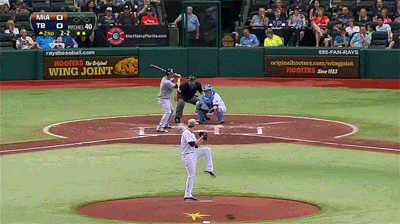
Odorizzi was lucky to get away with this slider, which creeps over the plate and just sorta sits there. That's the kind of mistake that makes a pitcher grateful that the batter is Jordan Brown.
12. 2-2: 85-mph slider, foul

This is a much better slider, but it still doesn't have enough bite to miss Brown's bat. "He's spent almost one inning pitching just to Jordan Brown here," says the same announcer.
13. 2-2: 92-mph four-seamer, foul

A "loose in the zone" four-seamer. Brown doesn't seem to be expecting a fastball, and he checks his swing instead of trying to drive a hittable pitch.
14. 2-2: 93-mph four-seamer, in play

Another fastball over the plate, but at the knees. Brown hits it fairly hard, but within range of James Loney.
It’s risky to read too much into a single plate appearance. But if one were going to use any particular PA as a microcosm of Odorizzi's start or season, it would be this one, since all of Odorizzi's strengths and weaknesses were on display. In the span of 14 pitches, the righty deployed four passable pitches and showcased what Jason called his "feel for sequencing," varying pitch types and locations to keep Brown off balance. He also demonstrated decent control, reaching the end of the plate appearance without throwing a third ball (albeit with some assistance from Brown). But he also suffered from some suspect command, getting away with a pair of fat pitches. And more importantly, it took him 14 pitches to get by Jordan Brown. Granted, Brown is a high-contact guy—he's struck out in only 13.0 percent of his Triple-A plate appearances—so it's not as if he failed to get the ball by, say, Dallas McPherson for 14 pitches. But Odorizzi isn't going to change his reputation for lacking an out pitch and being unable to put a stake in opponents by taking 14 pitches to retire a Triple-A journeyman.
(For more on Odorizzi's second start, read R.J. Anderson's impressions here.)
Fernandez vs. Joyce
Length: 7:35
Mound visits: 0
Joyce’s longest previous plate appearance: 12
Previous longest plate appearance vs. Fernandez: 9
2013 League-average P/PA: 3.85
Joyce P/PA (career): 4.12
Fernandez P/PA against: 3.77
Previous match-up history: 0-for-1, 1 K, 1 BB (earlier in same game)
Fernandez is everything Odorizzi isn't. His four-seamer is one of the five fastest in the majors (among starters), his curveball is better than any of Odorizzi's secondary offerings, and his change has made significant strides this season. No one questions his ability to miss bats or finish batters. Like Odorizzi, Fernandez's fastball command can be shaky, but unlike Odorizzi, his velo allows him to get away with mistakes. He's 20, and he skipped a couple minor league levels on his way to Miami, so he lacks Odorizzi's plus pitchability, but he makes up for the finesse he's missing with devastating stuff.
And yet Fernandez is also in this article because he failed to finish a batter off in fewer than 14 pitches. How did that happen? Fernandez was facing a tougher opponent, and one who takes plenty of pitches, but for the rest of the story, you'll have to scroll down.
The plot (catcher’s perspective):
The first pitch of the PA was low and doesn't appear on the plot, but there were really only a pair of safe takes in this entire sequence. (Something to keep in mind: Joyce likes to swing at high pitches.)
The exhausted player:
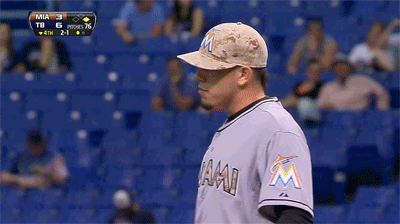
This PA took almost three minutes more than the battle between Brown and Odorizzi. In part, that's because there was a runner on base, who drew a couple throws. But baserunner aside, Fernandez was working much more slowly than Odorizzi. This was the end of his outing, and it showed.
The sequence:
1. 0-0: 93-mph four-seamer, ball

Here's the first of the two safe takes. Joyce isn't tempted.
2. 1-0: 93-mph four-seamer, foul

This isn't Fernandez's best fastball, but it matches Odorizzi's top speed in the Brown at-bat. Joyce is a little late.
3. 1-1: 81-mph curveball, ball
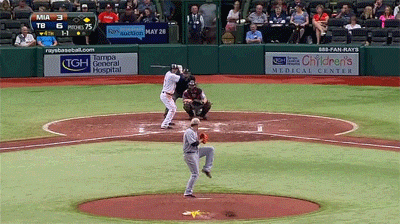
Not one of Fernandez's better curveballs. It moved, but not where he wanted it to. Still came close to being a strike.
4. 2-1: 84-mph changeup, swinging strike

Fernandez drops the change, and Joyce is way out in front. That's a thing of beauty, though it took courage to put it where he did. (Baseball courage, not defect-from-Cuba courage, which he also has.) Fernandez threw 14 changeups in this start. He got five called strikes, three swinging strikes, and four fouls. Not too shabby. The pitch ranged from 82 mph to 88 mph; it's probably more effective toward the low end of that range, where it gets greater separation from his fastball.
5. 2-2: 87-mph changeup, foul

This changeup is three miles per hour faster. Joyce still swings early, but not by as much, and he makes solid contact.
6. 2-2: 95-mph four-seamer, ball

Fernandez seemed somewhat gassed at this point. He got this pitch up to 95, but was probably overthrowing, and the pitch ended up high and outside.
7. 3-2: 79-mph curveball foul

Movement similar to the first curve in the plate appearance, but a better location. Joyce pulls his hands in, but he can't keep it fair.
8. 3-2: 85-mph changeup, foul

May have gotten away with one there. Again, Joyce is a little early, and he gets under the ball.
9. 3-2: 79-mph curveball, foul

If this curve had been a little higher, it could have been crushed. Fernandez didn't get the same sort of movement on it that he did on the first two.
10. 3-2: 83-mph curveball, foul

Even straighter, and closer to the center. Joyce hit it hard, but he was too quick, maybe because he's geared up for the fastball.
11. 3-2: 95-mph four-seamer, foul
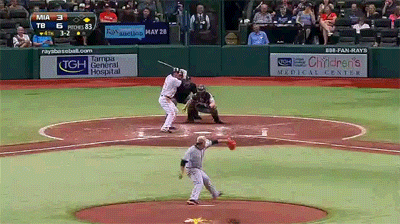
Which he gets, and puts a good swing on. It's just far enough inside that Joyce can't get the fat part of the bat on it. "He's up in Jordan Brown territory now," says a Rays broadcaster.
12. 3-2: 94-mph four-seamer, foul

Probably ball four, but a bit too close for comfort. Except for pitch no. 11, which he just missed, Joyce hasn't been able to get his timing quite right (which can happen when you're facing a pitcher who can blow the ball by you and also throw something 20 mph slower).
13. 3-2: 95-mph four-seamer, foul

Joyce's seventh consecutive foul. Exchange between Rays broadcasters: "Scintillating TV." "Isn't it?" "Can't get enough of it."
14. 3-2: 95-mph four-seamer, in play

And finally Fernandez misses over the middle with his heater, and Joyce makes him pay. It's not exactly a blistering liner, but it ends Fernandez's outing. In this case, the 14-pitch struggle was a combination of a good approach by Joyce, who spoiled pitches until he get one he could hit, and some slightly reduced stuff from Fernandez, who was at the end of his rope and didn't have his crispest curve.
Thank you for reading
This is a free article. If you enjoyed it, consider subscribing to Baseball Prospectus. Subscriptions support ongoing public baseball research and analysis in an increasingly proprietary environment.
Subscribe now
Ricky Gutierrez had a 20-pitch affair with Bartolo Colon of the Indians back in June 1998. He fell behind in the count 0-2. And it took 18 more pitches for Colon to strike Gutierrez out.